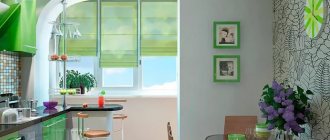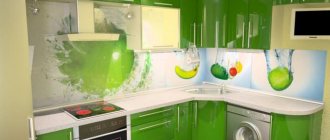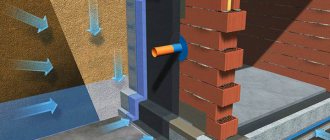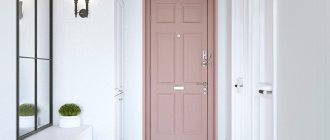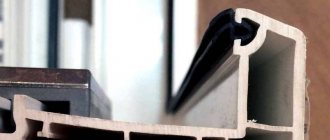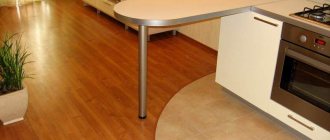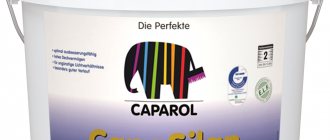When deciding what is best to make the floor in the kitchen on your own, you should initially focus on the microclimate of the room. Thus, the kitchen is characterized by sharp temperature fluctuations, high levels of humidity and the presence of soot and grease. For this reason:
- an ideal floor should be moisture-resistant, washable from dirt and grease stains with conventional detergents, and have a durable, perfectly flat and smooth surface;
- the flooring must withstand increased mechanical loads, not be afraid of scratches and other external damage due to large crowds of people, the movement of large pieces of furniture, falling cutlery or dishes;
- the chosen coating should naturally fit into the existing style of the room; its design can be bright - accent or laconic - background for other interior items.
When selecting this or that material for a kitchen floor, we recommend that you first become familiar with their features and the advisability of using them in a room with difficult operating conditions.
Pros and cons of wood floors
The kitchen floor, made of environmentally friendly material - natural wood, has a luxurious appearance. It can become an ideal addition to any interior, give your home a unique character, and give your household special comfort and warmth.
In addition, wood is a good thermal insulation material, which is why you can walk barefoot on the floor even in the cold season. We also note the ease of operation and everyday care - the paintwork is easily cleaned of dust, dirt and stains, it can always be renewed.
Wooden floors can be laid at any height from the base; if necessary, the coating can be set to any angle of inclination, which creates additional design possibilities.
The disadvantages include:
- wooden floors are susceptible to moisture - with regular contact, the coating turns black and rots;
- sharp temperature fluctuations have an equally detrimental effect on wood - the coating dries out and bursts, microcracks form on it;
- quite high cost - due to the complexity of the process of processing natural material and manufacturing locks and other fastening elements;
- the need to regularly treat wood with paint, stain, varnish and other chemicals that form a protective top layer.
A little about the practicality of color
Seamless tiles
When choosing a color scheme for the floor, you need to take into account that on very dark and very light coatings all the crumbs and drops are visible. I'll have to clean more often.
On a tile floor, light grout becomes dirty very quickly. There will be fewer problems with dirt if you treat the floor from dirt with a special protective compound.
Kitchen floor made from natural cork
No less popular and in demand today is the installation of cork flooring. This is due to the fact that such material has many advantages:
- Good thermal insulation - oak bark flooring consists of air-filled depressions, which makes it “warm” to the touch. This is an excellent choice of material for areas where there is a lot of barefoot walking.
- Health benefits - due to the elasticity of the cork material, the load on the spinal column and leg joints is reduced, and the floor “springs” while walking.
- Sound insulation - thanks to its porous structure, the floor is able to provide high-quality sound insulation in the room.
- Endurance to external influences - the material completely restores its original shape in a short time (when the dent is not very deep, it is not caused by a heavy object).
- Scratch resistance - “clean” cork is not placed on the kitchen floor; it is covered with a laminate or a special varnish. Both options are durable, reliable, and tolerate various types of mechanical damage.
- Aesthetic beauty - thanks to photo printing, the design of the coating can be anything. Most often it is imitated as oak boards, natural parquet or granite.
- Easy maintenance and care - the material can be easily cleaned of dust and dirt with a vacuum cleaner and a damp rag. The varnish coating reliably protects the cork from moisture penetration.
- Easy to install - the floor is “locked”; even a non-professional can install it independently.
- Affordable price - cork is much cheaper in cost than natural wood, but in terms of functional and aesthetic characteristics it is practically not inferior to it.
The main disadvantage of cork flooring is that it cannot withstand heavy weight. When moving large furniture on it, it is better to put soft felt under the legs so as not to “chew” the material.
Tile floor
How to lay the floors in the kitchen near the stove and sink, since they are exposed to the most intense external influences? An excellent solution is to use tiles that differ from other materials in the following advantages:
- ability to withstand bending - this indicator is determined by international standards. According to regulatory documentation, clay tiles on a kitchen floor cannot have a bending resistance of less than 25,000 Pa;
- wear resistance - the EU standardization system divides tiles into 5 classes, this allows you to select a coating for specific operating conditions. Thus, tiles of the first class are laid exclusively on walls, while tiles of the second class are laid on floors with little mechanical load. It is best to install third or fourth class tiles in the kitchen. The most highly durable fifth class is intended for arranging places with active movement of a large number of people, so it is not practical to spend money on purchasing it for the kitchen;
- resistance to aggressive chemicals - the material is able to withstand the destructive effects of detergents and retain its original appearance for a long time;
- slip resistance - in order for ceramic tiles to ensure safe movement of people around the kitchen, their coefficient of friction must be at least 0.4. The safest flooring material is corundum-coated and has a slip rating of 0.8. But you need to take into account: ribbed, wavy surfaces complicate the cleaning process.
We strongly do not recommend laying glazed tiles on the kitchen floor, as after wet removal they become slippery and can cause falls, bruises, sprains and injuries.
The ideal thickness of such a coating is 10-12 millimeters.
The disadvantages of tiles include their “coldness”; this problem can be solved by installing a heated floor under the ceramic coating.
Aesthetic possibilities of floor tiles
Correctly selected, carefully laid tiles on the base of the floor can advantageously emphasize the stylistic features of the room, hide shortcomings, and help bring to life the most daring design ideas.
Let us list some of the nuances of choosing a coating based on decorative characteristics and features of its installation:
- The correct choice of tile size allows you to visually adjust the dimensions of the room. For small-sized kitchens it is better to use small-sized stoves, spacious and tall - large. Complex designs visually reduce usable space, while simple ones increase it. When choosing, it is also important to be guided by the ease of installation - large slabs require less time, and the connections between them are smoother and neater.
- To improve the decorative effect, it is better to use unusually shaped models in the kitchen - polygonal (with the number of edges from 4 or more) or with rounded edges. Ornament also plays an important role.
- If we consider the flooring from a practical point of view, you need to remember that stains and traces of dirt are best distinguished on grainy dark materials and uneven colors. Chips and microcracks are most visible on a plain material, and a beige, light-colored floor requires daily cleaning.
- When you need to make an accent, it is best to choose tiles with a bright, rich pattern. If the flooring is the main background, for example, for a black and white furniture set, then an excellent solution is to make it light gray.
- Plates with a single pattern allow you to create separate functional areas of the kitchen. Solid patterns, on the contrary, combine usable space.
- The appearance of the coating is determined by the color of the grout: a plain color creates the appearance of a single surface, a contrasting one attracts attention. When the grout is slightly darker than the ceramic tiles, the floor looks neater and cleaner from the outside; light-colored compounds produce the opposite impression.
Important! This solution is not recommended for use in small kitchens with low ceilings, as it visually narrows the free space.
A modern design option for kitchen floor coverings is combining the slab with other decorative materials. In this case, the working area is covered with ceramics, the rest of the space is covered with several types of wooden covering or laminate.
Laying laminate flooring on a kitchen floor
Laminate is a floor covering that is highly resistant to moisture. It is most often made from high-strength fiberboard, which swells when exposed to moisture and loses its original characteristics. This can be prevented by a special coating that makes the floor surface waterproof, durable, resistant to external damage and mechanical stress.
Laminate types
Most often, panels of 32 or 33 wear resistance classes are laid on the kitchen floor, the special structure and locking of which ensure practicality and long-term operation during intensive use. Laminate made from natural cork, which has a soft texture and can retain heat in a room, is no less popular.
PVC-based laminate is also in demand because it has high noise absorption, thermal conductivity, and resistance to high humidity. Its waterproof base prevents swelling of the floor covering and its subsequent rotting.
Advantages of materials
Modern coating for the kitchen allows you to give the interior individuality, fill it with comfort and warmth. Each type of flooring material has the following advantages:
- laminate on a plastic base is easy to install - the absence of a chamfer allows it to be mounted on the floor without gaps, which ensures the safety of the structure and outer layer in case of accidental spillage of liquid. The coating is highly wear-resistant, has a wide variety of colors, absorbs noise well and withstands external damage;
- the natural cork coating is completely safe for human health, its surface is treated with a special composition that protects the internal structure from the penetration of moisture and various types of mechanical influences;
- Fiberboard laminate copes well with high humidity, thanks to the presence of special treatment of connecting locks and a protective epoxy layer located at the top and bottom. It is because of practicality, durability and wear resistance that this material is so often chosen for flooring.
Terrazzo
A seamless mosaic (terrazzo) coating in the kitchen will help create an individual interior. This pattern of individual elements will become an original decoration of the room and will suit any style, depending on the color and texture. An interesting option is to use not a classic mosaic made of glass or ceramics, but to create, for example, a covering made of marble or stone.
An excellent solution for a country house, the size of the kitchen-living room allows you to enjoy the pattern of the stone and walk on it without taking off your summer shoes.
Photo: diespeker.co.uk
Terrazzo gray mosaic 14.7*14.7 ceramic decor
RUB 373.2*
Buy
*Price may change
Linoleum
When deciding which floor to make in the kitchen with their own hands, many owners of apartments and country houses choose affordable, easy-to-use linoleum. Modern production technologies, the use of reliable and safe materials today make it possible to obtain a high-quality and durable product, which in its functional and aesthetic indicators is not inferior to alternative coatings.
Linoleum compares favorably with its competitors:
- wear resistance;
- hygiene;
- ease of installation;
- wide choice of colors;
- low cost.
Arranging such a kitchen floor is accessible to everyone. The material is easy to care for and easy to clean from dirt - the synthetic coating is resistant to abrasion and water.
By giving preference to the middle price segment, you don’t have to worry about damage to the surface due to the fall of heavy, sharp objects or exposure to hot grease drops.
In this case, it is better to avoid the accumulation of puddles on the surface; spilled liquid should be wiped dry with a soft cloth to avoid deformation of the material.
The advantages of linoleum include the ability to imitate almost any natural material. This floor can take the form of natural wood, marble, granite, cork, oak parquet or ceramic slab.
Selection factors: highlight the main thing
Before comparing different materials for finishing floors, I would like to discuss a point that many people overlook - what criteria need to be taken into account when purchasing?
It is important to consider all parameters
When it comes to a kitchen floor, it’s not enough to choose a beautiful and durable coating - there are a number of other nuances that we have highlighted in a separate list.
The ideal floor must meet all parameters:
- Moisture and water resistance. Even the most ideal housewife regularly spills a wide variety of liquids in her kitchen. Therefore, coverings such as carpet are unlikely to suit you - under the influence of water they swell and become deformed over time.
- Easy to care for . Drops of fat, pieces of food... Are you sure you have the patience to clean the complex textured coating from them every day?
- Resistance to mechanical damage. The stronger the floor, the longer it will last in your kitchen.
- Resistance to thermal influence. The bottom of the oven can get hot, and drops of boiling oil sometimes fall on the floor... A good coating should be able to withstand such incidents.
- Appearance. No matter how durable and reliable the floor is, if it does not match the design concept of the kitchen, it is unlikely to give you pleasure. Therefore, you will have to look for a middle ground between functionality and practicality.
However, do not be intimidated by such an extensive list: most modern coatings meet almost all of these criteria. Therefore, you only need to choose high-quality material from a well-known manufacturer - there is no need to skimp on floor finishing.
Modern floors can be completely different
We suggest you familiarize yourself with the different types of materials in more detail: we have described all their advantages and disadvantages to make it easier for you to make a choice. Let's get started?
Carpet
The soft carpet allows you to comfortably move around the kitchen even barefoot. It is laid all over the floor or combined with other materials, including parquet and tiles.
The advantages of carpet include:
- ease of installation;
- good sound insulation;
- possibility of combination with other materials;
- environmental cleanliness and health safety;
- ease of care;
- affordable price.
However, the coating also has some disadvantages:
- has low moisture resistance;
- accumulates dust, provides a comfortable environment for the proliferation of pathogenic microbes and small insects;
- does not tolerate sudden temperature changes.
The kitchen carpet can be natural or artificial. In the first case, it is made with 100% natural wool or combined with plant fibers: flax, cotton, hemp, etc. The coating is environmentally friendly, but its service life is much shorter than that of synthetic materials.
As for artificial carpet, it is more wear-resistant, practical, and absorbs less unpleasant odors, particles of dust and dirt. It is made from nylon, polypropylene or acrylic fibers, etc.
Nylon flooring looks natural from the outside, it is durable, and pleasant to the touch. The cost is a little more expensive than other synthetic raw materials, but with proper maintenance, such carpet can last more than ten years.
Note that the dirtiness and degree of wear directly depend on the pile - the denser it is, the more strongly the fibers come into contact with each other - which means less debris will get in. Closed-loop carpet has varying pile heights to create a dimensional effect. But due to the different lengths of the pile, such material becomes unusable much faster.
Marmoleum
Natural coating appeared relatively recently. Presented in the form of tiles or rolls.
It is made from plant resin, jute, and cork. Some models add flax oil, chalk, and wood flour to the composition. Dyes are added to the resulting composition, and then the mass is pressed and cut to the required sizes.
The technology for laying marmoleum is similar to installing linoleum, but is attached with a special glue. The coating can last about 50 years. Stains are easily removed from this coating, so it is easy to maintain.
The advantage of marmoleum is its antibacterial effect. Safe for allergy sufferers due to completely natural ingredients. It is able to withstand high temperatures, so you can install a floor heating system underneath it and does not fade in the sun.
Due to the strong hardness of the material, it is easy to damage during transportation and installation.
It's not cheap, but it can last up to 50 years and is completely safe for people, so it's worth the cost.
Self-leveling kitchen floors
They also have another name - “liquid linoleum”, because at the very beginning the material is a liquid mixture, which is distributed in an even layer over the base of the floor, and hardens over time. The result is a perfectly flat, smooth surface with many advantages:
- Hygiene - grease drops, dirt, moisture and small debris do not accumulate between the joints, because they are absent in a monolithic surface.
- Fire resistance, moisture resistance - unlike flammable laminate, linoleum or parquet, self-leveling flooring is not afraid of open fire flames and water ingress. It doesn't slip like ceramic tiles.
- Resistant to sunlight - does not lose its original color, like laminate or linoleum.
- Environmentally friendly - at high temperatures the material does not release harmful chemical compounds into the environment and is completely safe for human health.
- Long-term service life, ease of self-installation.
- Implementation of the most original design ideas - the ability to combine a large number of colors and shades, obtain three-dimensional floor patterns, etc.
- Unpretentious operation and maintenance - for cleaning you can use a vacuum cleaner and ordinary detergents.
- Resistant to external damage.
The coating also has some disadvantages:
- difficulty in dismantling - the mixture adheres firmly to the concrete base, removing it will not be easy;
- applying the coating will require certain knowledge, skills, and the use of a number of additional tools - a fine-toothed spatula, a needle roller, etc.
Porcelain tiles
Porcelain tiles do not absorb moisture, have high hardness and are invulnerable to high temperatures. Tiles can complement any kitchen interior. In the kitchen, you should use a matte look of tiles.
Its difference from ceramic tiles is that it does not have internal voids, porosity or microcracks, which increases strength. Does not deteriorate from various chemical detergents and temperature changes. It is harder than natural granite, making it very suitable for kitchen use. But with a very strong impact it can crack, so you still need to be careful.
Combined floors
The possibility of combining certain types of coatings on a kitchen floor should be determined at the initial stage of repair work, because small differences may arise between materials of different thicknesses that will need to be repaired.
A reasonable choice of kitchen floor covering for a particular functional area will visually improve the interior and bring the most original design fantasies to life.
Combination of laminate with tiles
Definitely, the floor in the kitchen should not be slippery or absorb moisture. Ceramic tiles and laminate combined in a single space combine these necessary qualities. The materials complement each other perfectly, have the same performance qualities and thickness.
For a kitchen space, you need to choose a laminate with the highest degree of moisture resistance and strength. It is better to give preference to a matte finish, because it is difficult to clean a laminated glossy board from dirt and dust. In addition, the laminate with a matte, textured surface has additional protection against slipping.
It is better to lay the material in the eating area - it is pleasant to the soles of the feet, retains heat well, and the insulating layer softens the sounds of steps. But it should not be used near a sink or hob, because laminate is susceptible to grease stains and high humidity.
It is best to equip the work area with tiles, which are highly durable and easy to maintain. Among the wide variety of colors, it is always possible to choose the best option for a specific kitchen style.
Important! It is better to lay embossed or wave-shaped tiles on the floor surface, because slippery glossy ones can lead to injury.
The combination of such materials looks interesting, stylish, the room takes on an elegant, original look.
The combination of tiles and laminate like oak or beech, marble, or natural stone looks unusual. Such a combination brings a touch of nobility to the interior and gives it an “aged” effect.
Linoleum, tiles
A simple, straightforward installation method at an affordable price. The materials are characterized by good heat and sound insulation and resistance to high humidity, softness, ease of maintenance and care.
A wide variety of color tones allows you to combine them harmoniously in various functional areas of the kitchen space. At the same time, linoleum can imitate expensive coatings - for example, oak parquet or natural wood flooring.
The minimum number of joints allows you to keep the kitchen floor perfectly clean. Linoleum is appropriate in the eating area, and wear-resistant, durable tiles are appropriate in the functional area. This combination is a wonderful combination of practicality and comfort.
Porcelain tiles, laminate
Artificial finishing material is similar to ceramic tiles, but has high strength and excellent anti-shock qualities - which is why it is often used for kitchen flooring. Its main advantages include: durability, resistance to aggressive chemicals, drops of fat and water.
On the domestic market, porcelain tiles are available in a wide variety of colors, so choosing the right shade for the laminate will not be difficult. The material in appearance can resemble natural wood, stone, metal, sand and leather.
We recommend placing it in places where moisture accumulates - near the sink or hob. And a laminate that is more comfortable to the touch is suitable for the eating area. Since the thickness of the coatings is almost the same, combining them in a single space will not be difficult.
Laminate, linoleum
Combining two flooring materials is the most popular solution for arranging flooring in the kitchen. After all, they have almost the same cost, service life, heat transfer, hygienic and functional characteristics.
Where you eat, linoleum can be laid in the form of a colorful carpet; it will also be appropriate near a gas or electric stove, because the material is not affected by humidity and is not afraid of sudden temperature changes. Laminate flooring will decorate your relaxation area.
Parquet and tiles
Such materials are not often combined. And in vain, because natural parquet can give the interior a luxurious look and fill the kitchen with special comfort and coziness. Natural material made from valuable types of wood is easy to maintain, easy to care for daily, easy to install, and easy to clean.
However, wooden boards do not withstand mechanical stress, temperature changes and high humidity, so they cannot be cleaned with abrasive detergents. It is perfect for recreational areas - the natural warmth of valuable wood is incomparable to any other coating.
Combining floors in the kitchen is a modern style solution that can truly surprise. It is enough to approach the matter creatively, show all your imagination, even with a limited budget you can decorate the floors in such a way that household members and guests will admire the exclusivity, practicality, and comfort of the interior.
Summarizing
Provence style
The choice of kitchen flooring depends on:
- family composition
- host preferences
- general style of the room
- room size
- location of kitchen areas
But there are basic recommendations:
- Absolutely any material will last a long time when the kitchen is rarely used and there are no children or animals in the family
- If you have a small kitchen space where you constantly cook, there are pets, objects often fall and liquids spill, tiles, porcelain tiles or vinyl are the best choice
- The combination of materials is suitable for rooms with several combined zones
- In a compact space of up to 5 m2, it is advisable not to use multiple materials
- When combining, it is necessary to determine in advance whether additional insulation will be used under the coating. This will affect the height of the rough layer. A cork expansion joint in the color of the parquet will look good at the joints
- Playing with directions when laying , tiles, laminate, boards will add variety to the space and divide it among themselves
- When agonizing over choosing, for example, wood or tile, which is better, you don’t need to make sacrifices between aesthetics and practicality. Nowadays it’s easy to choose tiles, porcelain tiles or vinyl with a wooden texture
You can find the perfect coverings for your kitchen. You just need to carefully understand this issue. Recommendations from professionals will help you make the right decision.
DIY floor arrangement
Before laying new material on the floor, all furniture, household appliances, etc. will need to be removed from the room. The worn-out coating must be dismantled. When old plywood or wooden boards are located underneath, their strength should be checked. This base is suitable for linoleum, but not tiles or laminate, which require a perfectly flat cement screed.
Its filling is performed as follows:
- All baseboards are dismantled.
- The old covering is removed - the tile is destroyed mechanically or cut along the contour of the seam with a grinder, the carpet and linoleum are rolled into a roll, after which all nails, staples, etc. are removed. Laminate, parquet is disassembled in parts and carefully folded (if still needed).
- The surface is cleaned of the previous screed, which usually has unevenness, cracks, etc.
After which the base is leveled. This must also be done for linoleum, which, after installation, completely repeats the texture of the surface. To level the floor, a solution is mixed from a dry mixture, which can be purchased at a specialty store. Slats of the same height are installed throughout the entire area. When pouring, they must be completely covered with the solution, after which they can serve as a reinforcing element.
A self-leveling liquid floor is easily applied to the cleaned base, which levels itself and hardens within one week. As a result, a monolithic, perfectly even layer is formed on which any coating can be laid.
Laying linoleum can be done in an alternative way. After waterproofing with rolled materials, a structure made of wooden slats is attached to the base, on which plywood sheets are placed. Bricks or concrete pillars can be used as the base, located at a distance of 15–25 centimeters from each other.
Concrete pillars are aligned using beacons measured using a level. The plywood sheet is then laid perfectly flat. After which the surface can be covered with linoleum, fixing it at the ends with nails with wide heads or staples. Near the walls, the covering is decorated with wooden or plastic skirting boards.
Prices
For comparison, we calculated the cost of each material for laying 9 sq.m. in a kitchen. Prices are average for the market and are indicated without taking into account the cost of work and consumables.
| Material/Price | Lowest, c.u. | Average, c.u. | Dear, u.e. | Very expensive, e.g. |
| Tile | 125 | 400 | 700 or more | 4000 or more |
| Porcelain tiles | 100 | 500 | 900 or more | 3000 or more |
| Laminate | ||||
| 31st grade | 30 | 70 | 200 or more | |
| 32nd grade | 35 | 120 | 200 or more | |
| 33rd grade | 40 | 130 | 200 or more | |
| 34th grade | 50 | 210 | 300 or more | |
| Linoleum | 20 | 45 | 70 or more | |
| Cork | 140 | 190 | 400 or more | |
| Tree | 60 | 100 | 150 or more | |
| Self-leveling floor | From 200 to 900 or more | |||
Installation of heated floors
There are 3 floor heating systems:
- water connected to the heating system;
- electrical cable;
- thin-film heated floor with an ultraviolet emitter or heating cable.
Such a variety of systems is due to the need to solve the problem of heating in certain living conditions. We will get to know each of them better.
- Water floor - it is unlikely that it will be possible to connect it to central heating, since doing this in an apartment building is strictly prohibited. But when the apartment is equipped with an individual heating system, or you live in a private house, such warm floors are the ideal solution. The system is installed at the cement screed stage - the base is covered with a layer of foam plastic and reflective thermal insulation. A reinforcing mesh is placed on top, and the pipes are coated with a special mixture. An expansion joint is made around the perimeter of the kitchen, which is necessary to expand the flooring when heated. It allows you to compensate for deformations caused by temperature changes.
- Cable electric flooring is the most universal solution, suitable for any situation. Similarly to the first case, it is mounted in a concrete screed (which will be covered with laminate, carpet, linoleum), or directly on it (if it is planned to lay tiles on top). It is clear that the arrangement of a heating system requires the availability of electricity as such. Such a warm floor consumes a lot of electricity; its consumption can be reduced by modern software devices with a thermostat that control the operation of the system automatically, preventing it from overheating and failure.
- Film flooring - thick material is laid directly on the screed; if necessary, it can also be mounted on a wooden structure. After the old coating is dismantled, a heat-reflecting screen is laid, a heating film and a new cladding are placed on top of it.
As you can see, modern systems allow you to complement each other - where it is not possible to use one of them, there is always a use for the other. In terms of safety, all of them are safe for human health (of course, if the installation was carried out in compliance with all norms and regulations).
